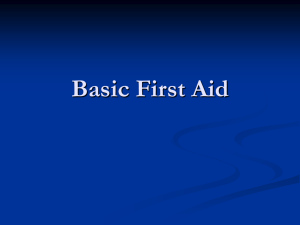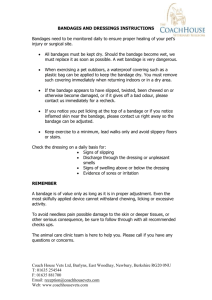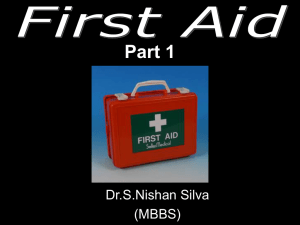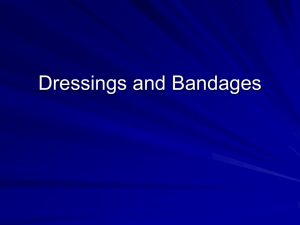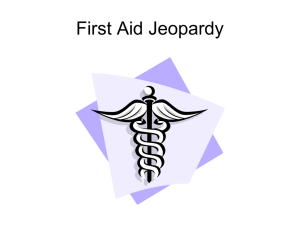Occupational First-Aid
advertisement
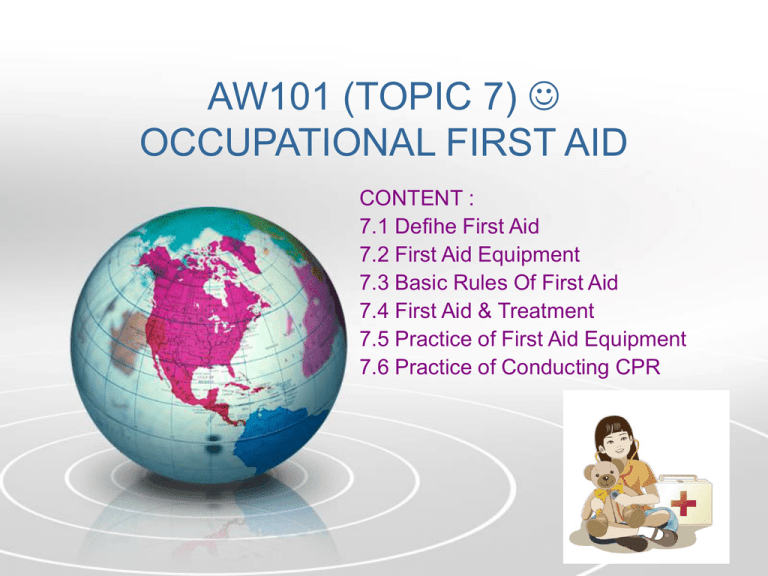
AW101 (TOPIC 7) OCCUPATIONAL FIRST AID CONTENT : 7.1 Defihe First Aid 7.2 First Aid Equipment 7.3 Basic Rules Of First Aid 7.4 First Aid & Treatment 7.5 Practice of First Aid Equipment 7.6 Practice of Conducting CPR 7.1 FIRST AID • It is the provision of initial care for an illness or injury. It is usually performed by a non-expert person to a sick or injured person until definitive medical treatment can be accessed. • In the United States, the Occupational Safety and Health Administration (OSHA) requires all job sites and workplaces to make available first aid equipment for use by injured employees • different jobs have different types of injuries and different first-aid requirements. The Aims of first aid can be summarized in three key points: 1. Preserve life - the overriding aim of all medical care, including first aid, is to save lives 2. Prevent further harm - also sometimes called prevent the condition from worsening,or danger of further injury, this covers both external factors, such as moving a patient away from any cause of harm, and applying first aid techniques to prevent worsening of the condition, such as applying pressure to stop a bleed becoming dangerous. 3. Promote recovery - first aid also involves trying to start the recovery process from the illness or injury, and in some cases might involve completing a treatment, such as in the case of applying a plaster to a small wound 7.2 FIRST AID EQUIPMENT @ KITS • first aid kit is a collection of supplies and equipment may be made up of different contents depending on who has assembled the kit and for what purpose. • It may also vary by region due to varying advice or legislation between governments or organisations • Standard kits often come in durable plastic boxes, fabric pouches or in wall mounted cabinets 7.2.2 FIRST AID EQUIPMENT Tweezers Glove Scissors Roller Bandage Thermometer Anticeptic wipes @ gauze Alcohol Antibiotic Ointment packets (approx. 1g) Cont….7.2.2 FIRST AID EQUIPMENT Triangular Bandage Adhesive Tape Jodine Adhesive tape (cloth) 1” Adhesive Bandage Aspirin Aspirin(chewable) 81mg 7.2.3 APPLICATION OF FIRST AID EQUIPMENT Glove Application ~ wear it during works with body liquid or any chemicals First aid equipments as earlier action to safe the life Bandage application ~ to stop bleeding Triangular Bandage Application ~ to hold Broken arm bone ~ to avoid broken @ injured movement Anticeptic wipes @ gauze ~ to clean up injured area 7.3 BASIC RULES OF FIRST AID • It is recommended that all kits are in a; i. clean ii. waterproof container to keep the contents iii. safe and aseptic • Kits should also be checked regularly and restocked if any items are damaged or expired out of date. • In general, the type of first aid facilities required in a workplace are determined by many factors, such as: the type of industry concerned; for example, industries such as mining may have specific industry regulations detailing specialised instructions the laws and regulation of the state or territory in which it is located the type of hazards present in the workplace the number of employees in the workplace the proximity to local services (doctors, hospital,ambulance). the number of different locations that the workplace is spread over 7.4 BASIC FIRST AID AND TREATMENT • • • • • Particularly the "ABC"s of first aid, which focus on critical life-saving intervention, must be rendered before treatment of less serious injuries. ABC stands for Airway, Breathing, and Circulation. Some organizations add a fourth step of "D" for Deadly bleeding or Defibrillation, while others consider this as part of the Circulation step. Some organizations teach the same order of priority using the "3Bs": Breathing, Bleeding, and Bones (or "4Bs": Breathing, Bleeding, Brain, and Bones). Variations on techniques to evaluate and maintain the life depend on the skill level of the first aider. Once the techniques are secured, first aiders can begin additional treatments, as required. There are a symbol of ; RED CROSS SYMBOL ISO FIRST AID SYMBOL STAR OF LIFE 7.4 BASIC FIRST AID AND TREATMENT 7.4.1 Burns and Scadals • • • • Burns, which can result in damage to tissues and loss of body fluids through the burn site. FIRST DEGREE: Flush with cool running water, Apply moist dressings and bandage loosely. SECOND DEGREE: Apply dry dressings and bandage loosely Do not use water as it may increase risk of shock. THIRD DEGREE: Same treatment as second degree. Continue… 7.4.1 Burns and Scadals Bagaimana Api bermula • Bahanapi adalah semua bahan boleh terbakar samada pepejal, cecair atau gas. • Udara untuk bernafas adalah 21% oksigen. Api hanya perlu 16% oksigen untuk membakar. • Haba adalah tenaga yang diperlukan untuk meningkatkan suhu bahanapi ketahap pengewapan bagi membolehkan penyalaan. APA YANG PERLU DIBUAT SEKIRANYA SESEORANG DISAMBAR API • Sekiranya rakan sekerja/orang lain disambar api, padamkan api dengan menyelimuti mangsa dengan blanket/guni. • Ini mungkin dapat menyelamatkan mereka dari melecur atau maut • Jika anda disambar api: BERHENTI - Ditempat anda disambar api , REBAH - Ke lantai & BERGULING Sekitar lantai • Meniarap dan merangkak untuk mengelakkan asap dan gas toksik • Tutup mulut dan hidung anda dengan kain lembap • Gunakan laluan kecemasan untuk bangunan bertingkat dan turun ke tingkat bawah • Buka tingkap untuk membenarkan udara luar masuk 7.4 BASIC FIRST AID AND TREATMENT 7.4.2 Bleedings • Heavy bleeding, treated by applying pressure (manually and later with a pressure bandage) to the wound site and elevating the limb if possible. • Apply DIRECT PRESSURE on the wound. use a dressing, if available. if a dressing is not available, use a rag, towel, piece of clothing or your hand alone. • IMPORTANT: ONCE PRESSURE IS APPLIED, KEEP IT IN PLACE. IF DRESSINGS BECOME SOAKED WITH BLOOD, APPLY NEW DRESSINGS OVER THE OLD DRESSINGS. THE LESS A BLEEDING WOUND IS DISTURBED, THE EASIER IT WILL BE TO STOP THE BLEEDING! If bleeding continues, and you do not suspect a fracture, ELEVATE the wound above the level of the heart and continue to apply direct pressure. If the bleeding still cannot be controlled, the next step is to apply PRESSURE AT A PRESSURE POINT. 7.4 BASIC FIRST AID AND TREATMENT ; 7.4.2 bleedings Pressure should be used in applying the bandage. After the bandage is in place, it is important to check the pulse to make sure circulation is not interrupted. For wounds of the arms or hands, pressure points are located on the inside of the wrist ( radial artery-where a pulse is checked) or on the inside of the upper arm (brachial artery). For wounds of the legs, the pressure point is at the crease in the groin (femoral artery). The final step to control bleeding is to apply a PRESSURE BANDAGE over the wound. Note the distinction between a dressing and a bandage. A dressing may be a gauze square applied directly to a wound, while a bandage, such as roll gauze, is used to hold a dressing in place. 7.4 BASIC FIRST AID AND TREATMENT 7.4.3 Shock electrical shock • The victim usually gets stuck to the source of the electricity, and it is important that you first separate him from the electrical source. • Turn off the power supply switch and disconnect the plug. It's best to simply turn off the main power supply or pull out the fuse. Often, simply turning off the switch may not stop the flow of electricity. • In certain circumstances it may be quicker to simply pull the victim away from the electrical source. • Do NOT touch the victim with your bare hands, or the electric current will pass through you as well. 3 keadaan yang perlu dipertimbangkan: 1. Laluan – masuk ke badan dan keluar 2. Jangkamasa sentuhan - Tahap kecederaanbergantung pada masa dan frekuensi arus.Kecederaan renjatan adalah dalaman, kesan luka yang boleh dilihat adalah pada bahagian masuk dan keluar arus. 3. Nilai arus atau tenaga mengalir ke badan iaitu: Lebih dari 1.5 A Kebakaran tisu dan organ dalaman 200 – 500 mA Penyepitan Jantung 100 – 200 mA Pengepaman jantung terhenti 30 – 75 mA Penyerabutan sistem respitori 10 – 40 mA Paralisis sistem saraf. 3 – 10 mA mengalami kesakitan, pengecutan otot 0.5 – 3 mA Terasa menggelenyar 7.4 BASIC FIRST AID AND TREATMENT 7.4.4 Bone Fractures • Bone fracture, a break in a bone initially treated by stabilizing the fracture with a splint. • Your first step in identifying a broken bone would be to check for deformity by comparing the injured counterpart on the opposite side of the victim's body. • Second, look for an open wound, which may indicate an underlying fracture. • Third, check for pain, which usually accompanies a fracture. The injured person will most likely be able to point to the area of pain. To assist in diagnosing a broken bone, gently feel along the bone. The victim will most certainly complain of tenderness or pain at the exact point of the fracture. • Fourth, notice if the injured area is swollen. Swelling in a fractured area happens rapidly, so look for this significant sign as well. 7.4 BASIC FIRST AID AND TREATMENT 7.4.5 Poisoning • • • • • • • Poisoning, which can occur by injection, inhalation, absorption, or ingestion. Try and identify the poison if possible Check for signs like burns around mouth, breathing difficulty or vomiting Induce vomiting if poison swallowed In case of convulsions, protect the person from self injury If the vomit falls on the skin, wash it thoroughly Position the victim on the left till medical help arrives 7.4 BASIC FIRST AID AND TREATMENT 7.4.6 Cardio Pulmonary Resuscitation (CPR) The steps of Cardio Pulmonary Resuscitation(CPR) • Investigate incidents, introduce yourself, check the level of awareness, move the body, seek assistance • lay the victim and do the ABC audit and check the whole body • If not breathing, give two breath support • Check the carotid artery, if there is a pulse continue CPR at a rate of 12 breath per minute. If no pulse immediately start pressure, the pressure of 15 times, do the following; 1) put your hand on the victims bodies 2) gave 15 times the pressure depth of 1.5 to 2 inches for adults 3) after given the pressure to give 15, the second blast (1 lap) 4) gave 15 times more pressure and then the second blast (2 rounds) 5) after four rounds check the carotid pulse 6) continue with CPR (15 2 blast pressure) if no pulse 7) did so experts arrive 7.4 BASIC FIRST AID AND TREATMENT 7.4.6 Cardio Pulmonary Resuscitation (CPR) • • • should have no heart beat (pulse), continue with CPR, check pulse 10 times after the blast, ready to perform chest compressions if no pulse If the victim starts to breathe without help, put him in the recovery position Check the breathing and pulse every 3 minutes 7.4 BASIC FIRST AID AND TREATMENT 7.4.6 Cardio Pulmonary Resuscitation (CPR) How to practice proper safe and methods in conducting CPR
